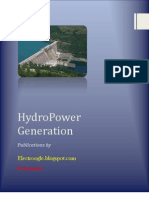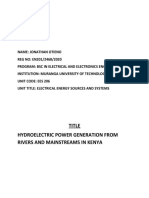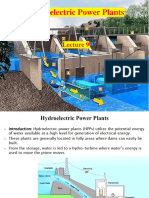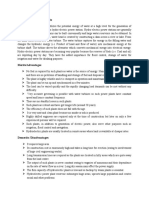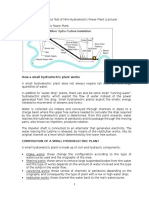Advantages of The KCT Over A Standard Hydroelectric Design
Advantages of The KCT Over A Standard Hydroelectric Design
Uploaded by
Andre StefaniaCopyright:
Available Formats
Advantages of The KCT Over A Standard Hydroelectric Design
Advantages of The KCT Over A Standard Hydroelectric Design
Uploaded by
Andre StefaniaOriginal Description:
Original Title
Copyright
Available Formats
Share this document
Did you find this document useful?
Is this content inappropriate?
Copyright:
Available Formats
Advantages of The KCT Over A Standard Hydroelectric Design
Advantages of The KCT Over A Standard Hydroelectric Design
Uploaded by
Andre StefaniaCopyright:
Available Formats
Advantages of The KCT over a Standard Hydroelectric Design
The table below generally compares the KCT hydro-technology with a standard hydro-electric plant
KCT Vortex Power Plant Minimum falling height down to 0.6m The vortex is self-regulating Hydropower Plant with a Kaplan or Francis Turbine Minimum efficient falling height down to 3m The expensive regulation system consists of adjustable blades (Kaplan) and a guide vane apparatus (Francis and Kaplan) The water quality diminishes due to the high pressures involved For optimal performance the falling height of a hydropower plant should be high as possible. Major dams are needed major impact on the environment Central electricity supply with few but large hydropower plants Existing hydro-plants are built for their output and only minor modifications are available in the future Existing hydro-plants need to stop rivers and dam up water, causing overflow issues, with turbines hindering the water flow in rivers. Existing hydro-plants must adhere to strict flow limits and the power restrictions that follow Efficiency significantly drops off at low levels At low heights, efficiency is very low
Water is aerated and provides a degree of purification Minimal impact on the environment
Many small hydropower plants can provide a de-centralised electricity supply Vortex hydro-plants can add to existing hydroelectric output Vortex does not have overflow issues or hinder the water flow in rivers Vortex power increases when put under a load regardless of flow Remains efficient at low loads Height alone does not determine the efficiency and so the vortex turbine remains efficient at low heights
Paul Kouris Managing Director Kourispower Pty. Ltd. 20 October 2010
You might also like
- How To Plan A Mini Hydro Power ProjectDocument15 pagesHow To Plan A Mini Hydro Power Projectmario5681100% (1)
- WINSEM2018-19 MEE2022 TH MB111 VL2018195002992 Reference Material II Hydro Electric Power PlantDocument46 pagesWINSEM2018-19 MEE2022 TH MB111 VL2018195002992 Reference Material II Hydro Electric Power PlantVishvajeet MohiteNo ratings yet
- Chapter-1: 1.1.induction GeneratorDocument12 pagesChapter-1: 1.1.induction GeneratorSURAJNo ratings yet
- Construction: Micro Hydro Is A Type ofDocument4 pagesConstruction: Micro Hydro Is A Type ofRyan Compala LictagNo ratings yet
- Micro Hydro-2017 - PDF RoomDocument6 pagesMicro Hydro-2017 - PDF RoomamacmanNo ratings yet
- Narrative Report About Hydro Power PlantDocument13 pagesNarrative Report About Hydro Power PlantDonabell B. MonteclarosNo ratings yet
- Hydro Power StructuresDocument29 pagesHydro Power StructuresVignesh TamilanNo ratings yet
- In Pipe HydropowerDocument45 pagesIn Pipe HydropowerYuvraj VermaNo ratings yet
- Hydrualic Turbine and Types On The Basis of HeadDocument4 pagesHydrualic Turbine and Types On The Basis of HeadOwais khanNo ratings yet
- My PGTD Lec 2Document34 pagesMy PGTD Lec 2Abdullah NawabNo ratings yet
- Hydroelectric Power Plants - Principles of Operation - EE Power SchoolDocument14 pagesHydroelectric Power Plants - Principles of Operation - EE Power Schoolharshitsingh.m99No ratings yet
- Hydro Electric PowerDocument67 pagesHydro Electric PowerPJ PJNo ratings yet
- Hydropower Energy: Literato, Karl Joseph Miguel, Noruel Jan Ocampo, Renz Marc Olaivar, Carlo Ornopia, Juvy Ann Rose FDocument9 pagesHydropower Energy: Literato, Karl Joseph Miguel, Noruel Jan Ocampo, Renz Marc Olaivar, Carlo Ornopia, Juvy Ann Rose FAsukaNo ratings yet
- Hydropower Engineering: Mohammed ADocument12 pagesHydropower Engineering: Mohammed AMymanNo ratings yet
- Hydroelectric Power Generation Notes (Publication by Electroogle - Blogspot.com)Document10 pagesHydroelectric Power Generation Notes (Publication by Electroogle - Blogspot.com)Usman UmarNo ratings yet
- Working Principle of Hydroelectric Power PlantDocument4 pagesWorking Principle of Hydroelectric Power PlantGummadi Amar100% (1)
- Efficiency of Various Turbines Based On Discharge RateDocument16 pagesEfficiency of Various Turbines Based On Discharge RateTansel YilmazNo ratings yet
- Hydro Power PlantDocument22 pagesHydro Power PlantSiti ZhakiyahNo ratings yet
- Proposal For ElecDocument12 pagesProposal For Elecjonathan otienoNo ratings yet
- Performance Test of Mini-Hydroelectric Power PlantDocument8 pagesPerformance Test of Mini-Hydroelectric Power PlantKram YnarNo ratings yet
- Lec - 9 PP - Hydroelectric - Power - PlantsDocument28 pagesLec - 9 PP - Hydroelectric - Power - PlantsLog XNo ratings yet
- Micro Hydro Electricity BasicsDocument13 pagesMicro Hydro Electricity Basicssebascian100% (1)
- Hydropower Glossary of Terms V FinalDocument7 pagesHydropower Glossary of Terms V FinalRAJESH KUMAR CHOUDHARYNo ratings yet
- Lecturer 13 Mini-HydropowerDocument13 pagesLecturer 13 Mini-HydropowerjishnuNo ratings yet
- Low Head Hydro MeterDocument4 pagesLow Head Hydro MeterAmar ShekharNo ratings yet
- RER Unit 2 Concise Notes Sidarth SirDocument21 pagesRER Unit 2 Concise Notes Sidarth Sirgociy20905No ratings yet
- HYDRO Power Plant PresentationDocument71 pagesHYDRO Power Plant Presentationfiraol temesgenNo ratings yet
- Hydro PowerDocument70 pagesHydro PowerOfficialmahesh boldhanNo ratings yet
- Laxapana Power Complex - 20EE0324 1Document12 pagesLaxapana Power Complex - 20EE0324 1Ravindu SanjanaNo ratings yet
- RRL - Run Off RiverDocument2 pagesRRL - Run Off RiverRhobin Paul RespicioNo ratings yet
- Hydroelectric Power PlantsDocument4 pagesHydroelectric Power PlantsShishir AcharyaNo ratings yet
- Main Renewable EnergyDocument75 pagesMain Renewable EnergyRajneeshNo ratings yet
- Hydropower PlantDocument40 pagesHydropower PlantHafeez Khan TareenNo ratings yet
- Performance Test of Mini-Hydroelectric Power Plant (Lecture)Document9 pagesPerformance Test of Mini-Hydroelectric Power Plant (Lecture)Alfred100% (2)
- Low Head Hydropower From Wastewater PDFDocument8 pagesLow Head Hydropower From Wastewater PDFमनीष कश्यप100% (1)
- Performance Test of Mini Hydroelectric Power PlantDocument2 pagesPerformance Test of Mini Hydroelectric Power PlantMilard Jan GolezNo ratings yet
- SPP1 4209-Hydro Power TechniquesDocument5 pagesSPP1 4209-Hydro Power TechniquesShariff Oluoch OdiwuorNo ratings yet
- Tidal Power: Non-Conventional Sources of EnergyDocument24 pagesTidal Power: Non-Conventional Sources of EnergyVarun BandarupalliNo ratings yet
- Pico HydroDocument9 pagesPico HydrodishkuNo ratings yet
- Plant Layout Parameters On The Risk of PulsationsDocument12 pagesPlant Layout Parameters On The Risk of PulsationsIbrahim HarrakNo ratings yet
- Hydro Electric Power PlantDocument52 pagesHydro Electric Power PlantHarpreet Singh KambojNo ratings yet
- Pelton Wheel Project Report 1Document15 pagesPelton Wheel Project Report 1Anonymous ytZsBOV92% (13)
- Micro-Hydro Power PDFDocument8 pagesMicro-Hydro Power PDFPedro Teixeira100% (1)
- Micro Hydro PowerDocument8 pagesMicro Hydro Powerlucas.barravaiteNo ratings yet
- Hydro Power PlantDocument41 pagesHydro Power PlantEr Mishal Gandhi100% (1)
- Types of Hydropower TurbinesDocument11 pagesTypes of Hydropower TurbinesfazarbadhushaNo ratings yet
- Hydroelectric Power PlantDocument25 pagesHydroelectric Power PlantPrasun BajracharyaNo ratings yet
- Laymans Guide To HydroDocument20 pagesLaymans Guide To Hydromushroom0320No ratings yet
- 22661-RET Notes-UNIT 04Document7 pages22661-RET Notes-UNIT 04jayeshdeore398No ratings yet
- HydroDocument18 pagesHydroali.ahsanNo ratings yet
- Hydroelectric PowerplantDocument47 pagesHydroelectric PowerplantAmit KhadkaNo ratings yet
- Hydroelectric Power Plant - Definition, Layout, Parts, Working, Advantages, Disadvantages & Applications (PDF)Document5 pagesHydroelectric Power Plant - Definition, Layout, Parts, Working, Advantages, Disadvantages & Applications (PDF)sureshNo ratings yet
- Hydro Power PlantDocument34 pagesHydro Power PlantAnshu HilsaNo ratings yet
- Introduction To Pelton Wheel TurbineDocument10 pagesIntroduction To Pelton Wheel Turbinealina.vacoeaNo ratings yet
- Report HydropowerDocument6 pagesReport HydropowerRolen VicenteNo ratings yet
- Hydro Electric PowerDocument78 pagesHydro Electric PowerVamsi100% (2)
- Unit 2Document39 pagesUnit 2Pradny WarkariNo ratings yet
- Small HydropowerDocument2 pagesSmall HydropowerEthan ElliotNo ratings yet
- Methods for Increasing the Quality and Reliability of Power System Using FACTS DevicesFrom EverandMethods for Increasing the Quality and Reliability of Power System Using FACTS DevicesNo ratings yet














